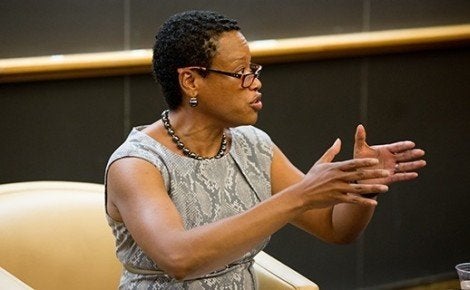August 3, 2015 — A recent string of racially motivated violence in the U.S.—including the horrific shooting deaths of nine people in a black church in Charleston, South Carolina in June—is deeply connected with a violent past that stretches back to the Reconstruction Era, according to Melissa Nobles of the Massachusetts Institute of Technology, an expert in racial and ethnic politics.
Nobles, Kenan Sahin Dean of the School of Humanities, Arts, and Social Sciences, and Professor of Political Science at MIT, spoke July 23, 2015 at Harvard T.H. Chan School of Public Health in Kresge G1. The event was presented in a Q&A format; Meredith Rosenthal, associate dean for diversity at Harvard Chan School, asked questions first, followed by members of the audience.
A legacy of violence and intimidation
In the decades just after the Civil War, particularly in the former Confederate states, life for blacks was marked by “unconstrained violence with no protection of law,” Nobles said. Lynchings were common; according to Nobles there were about 3,500 between 1888 and 1954.
Whites expected deferential treatment from blacks. Speaking out of turn or looking at a white person the “wrong way” could get a black person killed. Nobles recounted a story from the late 1930s of a young black man waiting for his luggage to be unloaded from a bus in Alabama. “He didn’t say ‘yessir’ to the bus driver,” Nobles said. “The bus driver called the cop. The cop killed him; he said [the passenger] had a knife. No knife was found. The violation was the notion that he had somehow acted out of line. He was not sufficiently deferential.”
Black mistrust of the police remains deep to this day, particularly in the South, Nobles said. Racial animus can spur fear of blacks on the part of whites and sometimes lead them to “self-deputize” themselves in public places to “discipline” unruly behavior. Statements from whites such as “he doesn’t belong in this neighborhood,” “the music is too loud,” or “you look irritated” are indicative of this tendency, Nobles said.
After recent questionable killings of blacks, Nobles said, there has been an implicit conclusion “that the victim was out of line, so that in some way their death was deserved or, more insidiously, that they were somehow complicit in their own death.”
Referring to the recent death of Sandra Bland after a seemingly routine traffic stop in Waller County, Texas—Bland was found dead in a jail cell three days later—Nobles said, “You drive your car and don’t signal changing lanes. A simple act and then you wind up dead? How is this?” (On the same day as Nobles’ talk, Bland’s death was ruled a suicide by Texas officials. A group of outside lawyers is now assisting the state investigation; the FBI and the Texas Rangers are also investigating.)
Guns and poverty
The prevalence of guns in America, as well as economic disparities, are both contributing to the racial violence faced by blacks, Nobles said.
“It’s clear that if you have guns, people will use them,” she said. “And in the states where you have these ‘right-to-defend-yourself’ laws, it puts too much power in the hands of the individual person”—especially given whites’ sometimes low threshold for feeling threatened by blacks, Nobles said.
As for the role of economics, she said that “poorer communities are differently policed than richer communities, and poorer people are treated differently by the police.” A March 2015 Department of Justice report about Ferguson, Missouri—where Michael Brown was killed in August 2014 after a run-in with a police officer—described extreme racial bias among police and the court system, a city where blacks are far more likely than whites to be charged with minor infractions, fined, and stuck in jail because they can’t afford to pay the fines. “The descriptions of Ferguson for poor black citizens sounded like a police state,” Nobles said.
A student in the audience asked Nobles how to help whites not be afraid of blacks.
Nobles said she didn’t have a good answer. “I imagine that black men and women have to come up with personal strategies as to how not to be seen as a threat,” she said. “It’s a sad commentary. The problem with that is that the burden ought not to belong to them alone.”
Read more
photo: Emily Cuccarese
